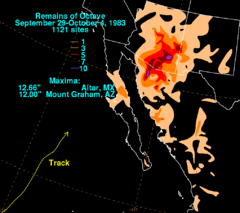- October 1983 Southwest United States floods
-
October 1983 Southwest United States floods Rainfall totals in Mexico and the southwest United States Duration: September 28-October 7 Fatalities: 13 total Damages: $500 million (1983 USD)
$1.1 billion (2011 USD)Areas affected: Arizona, New Mexico October 1983 Southwest United States floods was a flood that most significantly impacted Arizona and New Mexico. It occurred through the interaction of the remnants of Pacific tropical storm Octave, as well as a stalled low pressure area off the west coast of California. The combination contributed to torrential rainfall in Arizona, triggering widespread flooding. A total of thirteen fatalities was reported due to the floods, and damage amounted to $500 million (1983 USD). Heavy rainfall was also reported in Mexico.
Contents
Meteorological history
Well before to the start of the rainfall, much of Arizona was affected by a wet winter and subsequent monsoon season, leaving the grounds saturated and susceptible to flooding.[1] The origins of the flooding were from Tropical Storm Octave, which formed on September 27 off the southwest coast of Mexico. With an area warm temperatures, it was able to quickly strengthen to peak winds of 50 mph (85 km/h).[2] The next day, moisture from the storm began spreading across Mexico and the southwest United States, due to a stalled low pressure area off the coast of California drawing the thunderstorms northeastward.[1] By September 30 Octave was accelerating to the northeast, steadily weakening due to cooler waters and higher wind shear. That day it weakened to tropical depression status,[2] and on October 1 a steady rainfall developed across southeastern Arizona.[1] Octave eventually dissipated on October 2 off the west coast of Mexico,[3] the same day that the heaviest rainfall ended.[1]
Preparations, impact, and aftermath
The rainfall event lasted for one week, from September 28 to October 4.[1][4] Due to the threat for flooding, local flood warnings were issued for much of Arizona.[5]
In Arizona, the highest rainfall associated with the event was 12.0 in (300 mm) at Mount Graham.[4] Elsewhere, Nogales reported 9.83 in (250 mm),[6] portions of Tucson received over 8 in (200 mm), and Mount Lemmon experienced 10.45 in (265 mm).[1] In Tucson, flood waters reportedly reached 8 ft (2.4 m), stranding hundreds of people on rooftops.[7] Throughout the state, excessive rainfall caused many rivers to overflow. Water releases from the Coolidge Dam forced 75 residences to evacuate.[8][9] After the rainfall ended, the Santa Cruz, Rillito, and Gila rivers experienced their highest crests on record.[1]
The Mohave and Yavapai counties were particularly hard-hit. A relief helicopter crashed in attempt to rescue a woman and her baby, killing its two crew members.[10] Five towns – Clifton, Duncan, Wilkleman, Hayden, and Marana – were all almost entirely flooded.[1] Authorities were forced to close Interstate 10 when the Gila River destroyed a bridge.[11] Damage to roads and highways in the Tucson area surpassed $10 million (1983 USD, $22 million 2011 USD)).[10] The flooding destroyed or heavily damaged 1,300 houses,[1] and overall about 10,000 people were left temporarily homeless.[6] Across the state, the floods killed 13 people and injured hundreds more. Damage in Arizona totaled $500 million (1983 USD, $1.1 billion 2011 USD).[1]
On October 3, Governor Bruce Babbitt declared a state of emergency. Concerns arose regarding the state of several areas and possible disruptions in the delivery of food and other supplies.[12] President Ronald Reagan declared Arizona counties Cochise, Gila, Graham, Greenlee, Pima, Pinal, Santa Cruz and Yavapai a "major disaster area" on October 5.[13]
The rainfall affected areas outside of Arizona. In New Mexico, a peak total of 5.42 in (138 mm) was recorded.[14] In that state, the rainfall also caused flooding that forced people from their homes and damaged a portion of U.S. Route 180. New Mexico governor Toney Anaya declared a state of emergency in Catron County.[15] Rainfall was also reported in California, but that was mostly due to an upper-level low. In Mexico, 12 in (300 mm) was reported in Altar, while lighter totals between 1–3 in (25–75 mm) were reported along the Baja California peninsula. Along the Mexican Riviera, there were isolated reports of 1 in (25 mm).[4]
References
- ^ a b c d e f g h i j Tucson, Arizona National Weather Service (2008). "Tropical Storm Octave 1983". NOAA. http://www.wrh.noaa.gov/twc/tropical/Octave_1983.php. Retrieved 2010-12-14.
- ^ a b 1983 Hurricane season. 101. Eastern Pacific Hurricane Center. July 1985. Bibcode 1984MWRv..112.1419G. doi:10.1175/1520-0493(1984)112<1419:ENPTCO>2.0.CO;2. http://journals.ametsoc.org/doi/pdf/10.1175/1520-0493%281984%29112%3C1419%3AENPTCO%3E2.0.CO%3B2.
- ^ "Eastern Pacific hurricane best track analysis 1949-2010". National Hurricane Center. National Oceanic and Atmospheric Administration. March 2011. http://www.aoml.noaa.gov/hrd/hurdat/tracks1949to2010_epa.html. Retrieved 2010-03-22.
- ^ a b c Roth, David. "Remains of Octave". Hydrometeorological Prediction Center. http://www.hpc.ncep.noaa.gov/tropical/rain/octave1983.html. Retrieved 12-10-2010.
- ^ "Showers drench nation, flood continues in Arizona". Boca Raton News. October 4, 1983. http://news.google.com/newspapers?id=GlRUAAAAIBAJ&sjid=go0DAAAAIBAJ&pg=2031,909722&dq=arizona+flood&hl=en. Retrieved 27 November 2010.
- ^ a b "Arizona tropical cyclones". National Weather Service. http://www.wrh.noaa.gov/psr/tropics/hurricanes.htm. Retrieved 5 June 2010.
- ^ "Arizona flooding strands hundreds". Bangor Daily News. Oct 3, 1983. http://news.google.com/newspapers?id=imE0AAAAIBAJ&sjid=1OAIAAAAIBAJ&pg=2420,1332456&dq=arizona+flooding&hl=en. Retrieved 27 November 2010.
- ^ "Continued Rain Deepens Arizona Flood Misery". The Lewiston Daily Sun. October 4, 1983. http://news.google.com/newspapers?id=lnsgAAAAIBAJ&sjid=t2cFAAAAIBAJ&pg=4596,361920&dq=arizona+flood&hl=en. Retrieved 27 November 2010.
- ^ "Flood cleanup in Arizona to get underway". Lodi News-Centinel. October 7, 1983. http://news.google.com/newspapers?id=jTgzAAAAIBAJ&sjid=ijIHAAAAIBAJ&pg=6887,4304480&dq=arizona+flood&hl=en. Retrieved 27 November 2010.
- ^ a b "Thousands Flee Flooding in Arizona". The Palm Beach Post. October 3, 1983. http://news.google.com/newspapers?id=A_8sAAAAIBAJ&sjid=Ks0FAAAAIBAJ&pg=5102,2614586&dq=arizona+flooding&hl=en. Retrieved 23 November 2010.
- ^ "Arizona Flooding Aftermath". Gainesville Sun. October 5, 1983. http://news.google.com/newspapers?id=zbARAAAAIBAJ&sjid=yekDAAAAIBAJ&pg=5529,1161402&dq=arizona+flooding&hl=en. Retrieved 23 November 2010.
- ^ "Eight feared dead in Arizona floods". Lodi News-Sentinel. October 3, 1983. http://news.google.com/newspapers?id=iTgzAAAAIBAJ&sjid=ijIHAAAAIBAJ&pg=5820,3694596&dq=arizona+flood&hl=en. Retrieved 27 November 2010.
- ^ "Officials asses Arizona flood damage". Pittsburgh Post-Gazette. October 10, 1983. http://news.google.com/newspapers?id=Uq5RAAAAIBAJ&sjid=0G0DAAAAIBAJ&pg=4769,2372730&dq=arizona+flood&hl=en. Retrieved 27 November 2010.
- ^ Roth, David. "Tropical Cyclone Rainfall for the West". Hydrometeorological Prediction Center. http://www.hpc.ncep.noaa.gov/tropical/rain/tcwest.html. Retrieved 12-10-2010.
- ^ Arthur E. Rotstein (1983-10-04). "Arizona Flood Damage Climbs". The Spokesman-Review. Associated Press. http://news.google.com/newspapers?id=kVdWAAAAIBAJ&sjid=6e4DAAAAIBAJ&pg=6994,1738214&dq=mexico+flood&hl=en. Retrieved 2010-12-14.
See also
- List of Arizona hurricanes
- Floods in the United States: 1901–2000
- 1983 Pacific hurricane season
Categories:
Wikimedia Foundation. 2010.

